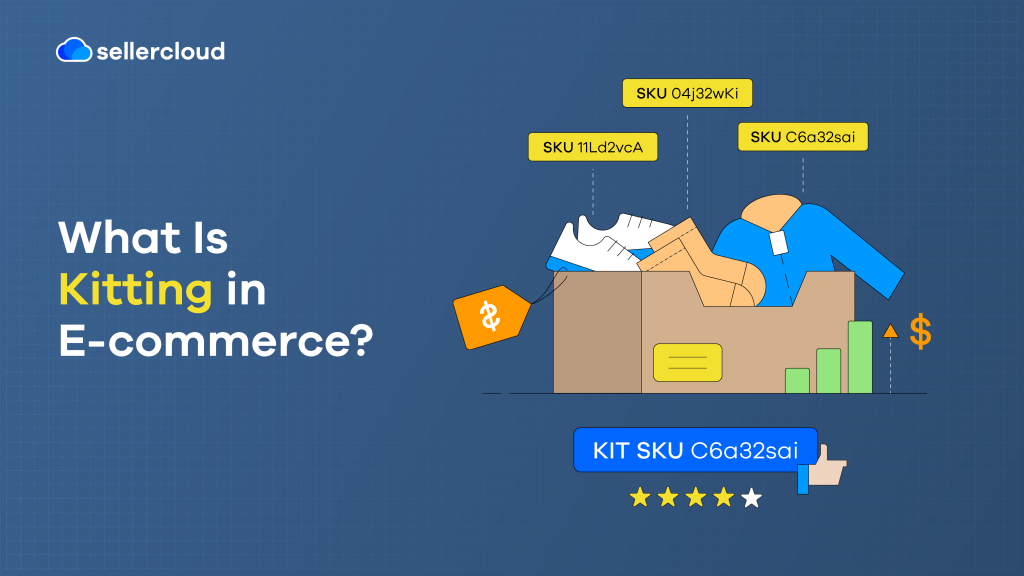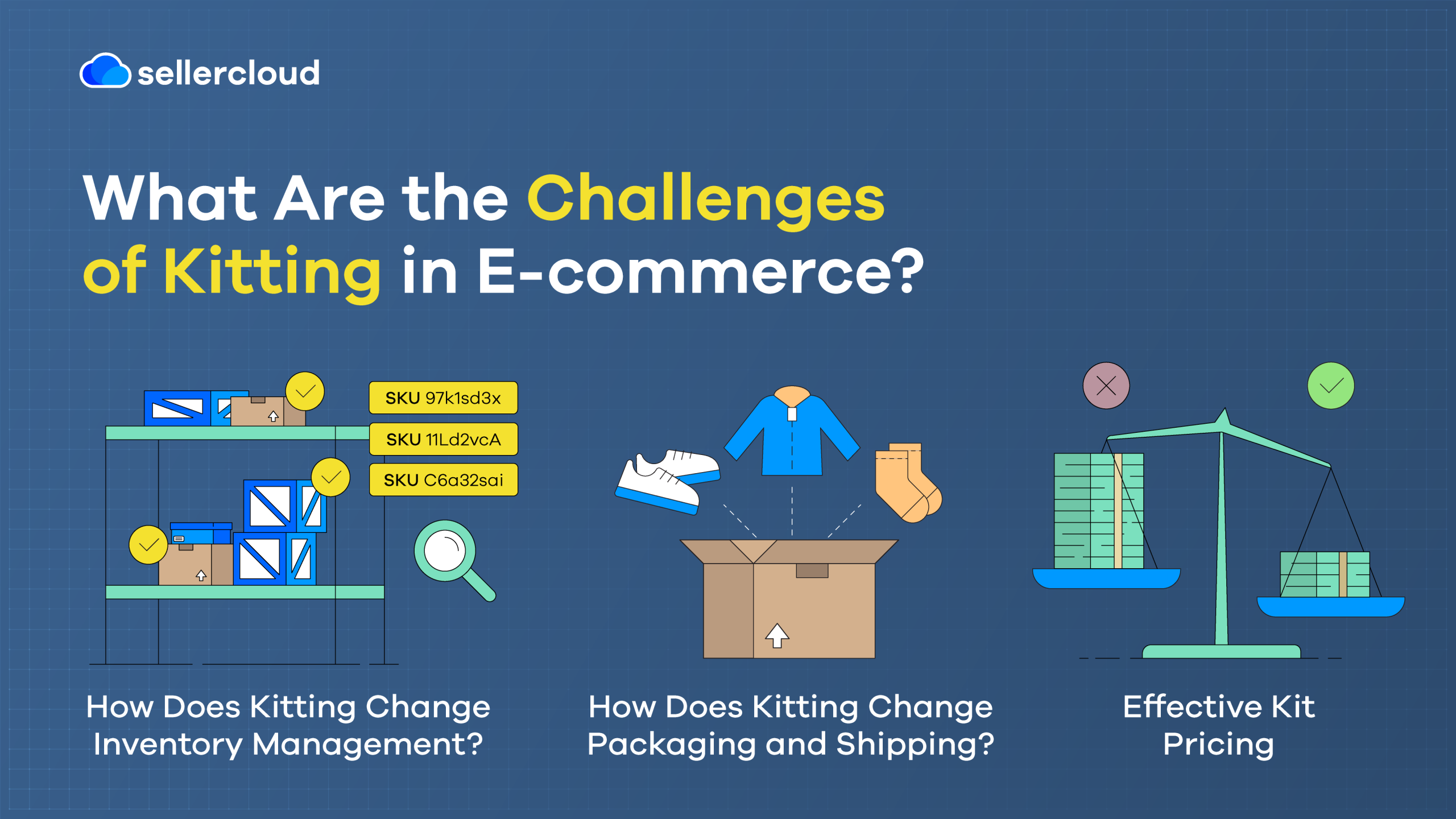
- ‘Kitting’ is where sellers combine multiple products as a package and sell them as one. There is a wide range of benefits both for the seller and buyer.
- Descartes Sellercloud and Skustack make kitting more efficient and help sellers defeat challenges when selling on multiple platforms.
Has your ecommerce company been looking for a way to increase sales and simultaneously improve customer satisfaction? Well, you’ll be happy to know that ‘kitting’ is one of the best ways to do just that. It’s a win-win for both customers and sellers.
In this article, we’ll explain what kitting means in ecommerce, the benefits of kitting, how to kit products and recognize kitting opportunities, and avoid some of the challenges.
What Is Kitting in Ecommerce?
In short, ecommerce kitting is where online sellers combine multiple products into one package to be sold as a single product. It can be an effective method of upselling products. The products that make up a kit are called ‘components’ or ‘children,’ each with its own SKU. However, the products are sold under one SKU when sold as a kit.
You won’t just see kitting in ecommerce; you’ll also find it with software packages and courses. Often, if one of the items in the kit is out of stock, the kit is out of stock, too. However, this can depend on the rules you set for your kit.
Usually, the items are associated with each other, and it’s uncommon to see items from different categories kitted together. A significant part of kitting is the customer experience. Kits can be convenient, time-saving, and tailored specifically for customers and save them money.
What Is an Example of Kitting?
Examples of kitting across ecommerce in almost every product category, though perhaps skincare and cosmetics are the biggest examples.
A great example of the benefits of kitting can be found in P3 Global’s Descartes Sellercloud testimonial. For P3 Global, kitting is very important because they sell many phone accessories packaged together and offer a variety of ways to mix and match products in a kit.
Co-founder Vimal Prajapati explains, “If you look at one of our kits, we have a cell phone cable, a wall adapter, and let’s say a case,” all of which can be sold individually or as a combination. Prajapati continues, “You can take those three root items and then create a lot of different SKUs,” which he explains has more potential for creating customer value.
What are the Benefits of Kitting for Ecommerce?
Kitting is advantageous for both sellers and buyers. The top benefit for sellers is that kitting increases order value size and optimizes shipping. To explain, selling many kits instead of individual products will save money on shipping and packaging.
Another significant benefit for sellers is that kitting can encourage buyers to try a new product if you offer it with a product that typically sells well. This is a great way to boost sales of a product that doesn’t sell well and is at risk of becoming a burden at your warehouse.
Merchants can boast that kitting is more sustainable because it means fewer emissions and less wasteful packaging. For buyers, kitting makes online purchases more practical and can win them over your competitors because you offer more in one package.
On top of that, kitting can foster a more personalized experience, which can encourage loyalty.
How to Kit Products in Ecommerce?
There’s more to kitting than just packaging two products together.
How to Recognize Kitting Opportunities?
Kitting opportunities come in many forms, and there are many ways you may want to experiment with kitting products. Access to sales data is key to spotting kitting opportunities. One way is to segment your customers based on past purchases and offer them kits composed of similar products.
You can also do this with products they have previously viewed, added to a wish list, or if they abandoned a shopping cart. Following up with an email to offer a deal based on what customers previously looked at can prove very successful in getting them to return.
You can also look into seasonal kits. For example, clothing retailers can kit out summer clothing items usually bought together as summer gets closer. There are also buyers looking for gift ideas for birthdays, the holiday season, or Valentine’s Day, for example, and kitting makes it much easier for them to buy presents quickly for loved ones.
Kitting is especially beneficial if the buyer doesn’t know much about the product category, which can mean spending less time making decisions. Of course, this does mean knowing what items are typically ordered together.
Lastly, don’t forget to analyze the success of your kits to see if improvement is needed or if a kit’s success can be replicated in similar ways with other products. Alternatively, you can create kits based on top-selling products or centered on a theme.
Top Tips for Kitting
Firstly, your warehouse should have a dedicated space for kitting, which may mean you’ll need to reallocate some of the space you currently use for inventory. Secondly, you may need to reorganize and train your staff to handle and package kits, which can take time.
Some businesses prefer to kit products beforehand to be more prepared for shipping. However, that requires determining the demand for your kits before they are available, which can be hard if you don’t have the data readily available.
Alternatively, some companies outsource kitting to their fulfillment partners. This saves them time from kitting and means they don’t have to reorganize their warehouses, though there is a cost factor to consider.
You may also want to optimize your website to suggest kits when customers land on a product page. Think of Amazon’s ‘Frequently Bought Together’ feature. As mentioned above, pairing products that sell well with those struggling is a great way to prevent dead stock and excess inventory.
Also, if your ecommerce business wants to improve its customer experience, you can include small rewards with your kits, such as vouchers and a personalized thank you note. Rewards can include free samples or other small gifts to thank the customer for their purchase, which can build brand loyalty and make your business stand out from the competition.
However, it’s also important to consider when and how often you want to make each kit a personalized experience and offer free gifts. You need to decide if your customers should expect to be rewarded every time they order a kit or only on their first order. Or would it be better to reward only returning customers? It all comes down to calculating your customers’ lifetime value.
What Are the Challenges of Kitting in Ecommerce?
Though kitting presents sellers with a range of benefits, because more steps are involved, sellers need to be cautious not to make mistakes. That said, sellers can avoid these challenges with effective planning.
1. How Does Kitting Change Inventory Management?
Kitting can make inventory management more complex because sellers must ensure that all kit components are available in sufficient quantities to meet demand. This means sellers must be able to track, forecast, and coordinate to avoid stockouts or overstocking.
To do that, sellers need to analyze historical sales data, customer preferences, and market trends to forecast the demand for their kits accurately. This can be difficult if a seller has never done this before. Furthermore, they might not have access to such data or the time to analyze it.
Kitting also impacts replenishment planning as sellers must consider the inventory needs for individual components and complete kits. This means sellers must ensure they have sufficient stock of individual items to assemble kits and enough complete kits to meet customer demand.
Failing to designate the correct number of kit components and products for individual sale can result in stockouts and overstocking. While individual components may have adequate stock levels, a shortage of one item can lead to a stockout of the entire kit. On the other hand, if certain kits do not sell as expected, retailers may have an excess inventory of specific kits, which can be costly.
Lastly, suppose a customer wants to return or exchange a kit. In that case, sellers must manage the disassembling of the kit, restocking the individual components, and ensuring that inventory is accurately updated for the components and the returned kits.
Such processes can be time-consuming and often require software to automate the process to prevent mistakes and provide real-time visibility into stock levels.
2. How Does Kitting Change Packaging and Shipping?
Assembling kits and packaging them can be time-consuming and labor-intensive, so sellers may want to explore how they can reduce the time required. Retailers must establish efficient processes for assembling kits and ensure they are packaged securely to prevent damage during shipping.
Regarding shipping, kits may require different packaging, handling, and shipping processes than individual products. So, sellers must consider a kit’s size, weight, and fragility to determine the most cost-effective and efficient fulfillment methods.
Additionally, coordinating inventory replenishment, order picking, and shipping for kits adds complexity to the logistics process.
3. Effective Kit Pricing
Determining the right price for each kit can be another challenge. Retailers must consider the costs of the components, the value added by bundling them, and the customer’s perceived value. Remember, shipping costs for kits will be lower than shipping products individually, but you also have to make the kit enticing by offering a discount.
Ultimately, it comes down to balancing profitability and customer satisfaction. Of course, no seller wants to be making a loss on a successful kit.
Overcoming Kitting Challenges With Descartes Sellercloud
Descartes Sellercloud seamlessly overcomes the many challenges of kitting and gives sellers the control they need, no matter which ecommerce platforms they sell on. When kitting products with Descartes Sellercloud, you can set up the relationship between the items in the kit.

In Descartes Sellercloud, there are three types of kits:
- All Component Kit. Only available when all components are available.
- Main Component Kit. Only available when a designated component is available.
- Independent Kit. This type is best for preassembled kits. Quantity is not based on the components, and the sale of the kit will not impact the quantity of the components.
Here’s how the above kit types work if you have 100 kit units.
With All Component kits, if you have 100 kit units available and simultaneously sell the components separately, if one component is sold, it impacts the entire stock of the kit. Your 100 units become 99 units as soon as one component is sold.
With Main Component kits, the kit quantity only depends on one component from the kit—if 100 of the main components are available, the kit has an inventory of 100.
Meanwhile, with Independent Kits, you designate 20 kit units from your 100 to be sold only as kits. You have 80 of each component left to sell separately, and once they are sold, the individual stock is gone—you cannot sell the 20 you reserved for kits individually.
Correctly designating components to a kit type can prevent sellers from making inventory errors, such as unintentional stockouts. You can even create kits in bulk through a file import, send kits to FBA to handle fulfillment, and disassemble kits whenever needed.
Descartes Sellercloud also enables sellers to calculate and manage the total cost of a kit, reserve inventory for kits, and ensure kits are updated on all channels while you sell individual components elsewhere. Merchants won’t need to worry about losing track of the number of components and kits they have in stock, as Descartes Sellercloud will automatically calculate it.
On top of that, Skustack, Descartes Sellercloud’s flagship mobile app for optimizing bin management, features a kitting module to assemble and disassemble kits by scanning or entering component SKUs. This enables warehouse workers to assemble a kit quickly and easily and helps keep track of inventory in real time.
Key Points
Ready to start kitting products at your ecommerce store? Keep in mind these key points.
- Kitting is where sellers offer products bunched into one order and sold as one product.
- Kitting increases order size value, reduces packaging and shipping costs, and encourages customer loyalty.
- Some challenges to kitting include complex inventory management tasks, time-consuming packaging, and ensuring you price your kits effectively.
- Descartes Sellercloud and Skustack make it easier to assemble kits and track inventory across ecommerce platforms and in the warehouse.
Book a Descartes Sellercloud demo today.





